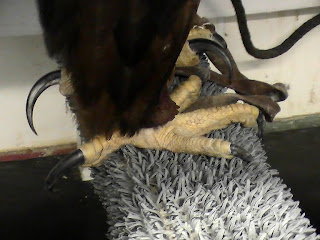So, yes, it’s all true! I have a new bird in my life, and he’s pretty adorable, if I do say so myself.
I’d love to introduce him to everyone. His name is Flip and he’s a juvenile Red-shouldered hawk. Red-shouldered hawks are a common species in the area, often found hunting around water. They love tasty rodents, but also eat lizards, snakes, and frogs.
As adults, these birds have a black and white striped tail, rust and cream chests, and rust shoulder patches, as their name implies. Flip looks a little different right now. He is full size, but still has his tan-spotted juvenile plumage on his breast.
He came to our Wildlife Hospital in May of 2009 with a broken wing. The break was stabilized, and healed over time; however, it became clear pretty quickly that this break had done damage to some of the follicles from which his primary flight feathers grow. The primaries are the outermost wing feathers. This damage caused these feathers to be…well… flipped, and grow in upside down. This situation has made Flip unable to fly and therefore unreleasable. He is, otherwise, a healthy young bird with a healthy dose of attitude.
This is the point at which I met him. Red-shouldered Hawks are a species that our Education department is allowed to have, through our federal and state permits, to use in our programs if they are non-releasable. We have not had a Red-shouldered Hawk since our beloved Meramec passed away from old age. Meramec was an awesome bird, who could frequently be heard calling from his perch at the Visitor’s Information Center weathering area. While he was loved by many, Meramec was very special to me because he was the first bird I ever handled on the glove when I began as an intern at the Sanctuary. When it was suggested that we could train this young unreleasable bird, soon to be known as Flip, to be part of our Education team, I jumped at the chance to do so. That was February.
Since then, Flip and I have been spending lots of time together each day working on his training. Flip’s first interactions with people were pretty negative since he had to be medicated and examined during his stay in the hospital. These are the times you most wish you could somehow tell these sick and injured birds that you’re only trying to help them. That communication not being possible, though, Flip wasn’t super-excited about the prospect of hanging out with me in the beginning. Many days were spent getting him to be comfortable eating with me in view. Soon we worked up to him taking food from my glove, and eventually to him stepping up on the glove to eat. I can’t tell you the joy that comes from that first day where you start to see some tentative trust from the bird.
Flip has made progress in leaps and bounds towards being comfortable in the presence of people other than me. He gets to go outside with the other birds each day where he can see lots of visitors, cameras, strollers and all kinds of new things that can be a little scary at first. We’re currently working on walking around the site while he’s eating off the glove so he can see new areas of the Sanctuary.
In the near future, Flip will learn how to travel in the carriers we use to transport our birds on our nationwide travels. The pinnacle moment will be taking him to his first education program. When this happens, I know I will be ridiculously excited and proud, and a little nervous, like a new parent sending a child off to the first day of school. It sounds a little dorky, I know, but good training requires a lot of time, careful observation, and an understanding of your bird’s personality. I’m afraid this professional closeness also breeds some emotional dorkiness. It’s a job hazard, what can I say?
None of this would have been possible without the intervention of our hospital personnel and the excellent care he received there upon first arrival, and during his long recuperation.
So, on your next visit to the Sanctuary, be sure to check out the row of perches just past the Wildlife Hospital and say hello to Flip. He’ll be the chatty one on the first perch. I know you’ll all find him as adorable as I do!
Submitted by Dana Lambert, World Bird Sanctuary Naturalist











































